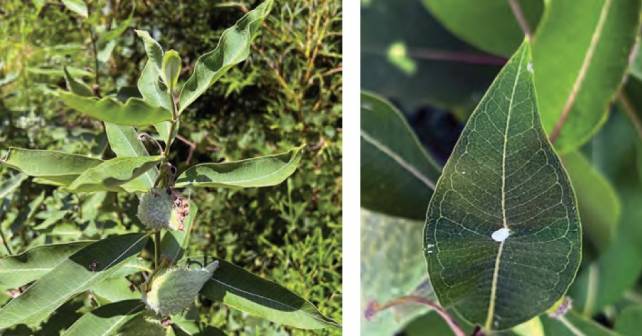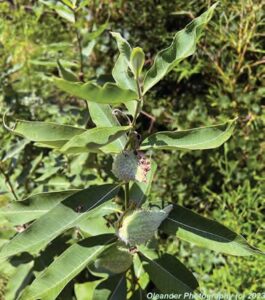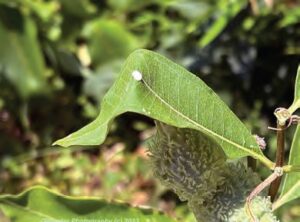
Milkweed, genus Asclepias, (named by Linnaeus as Asclepius (Ἀσκληπιός) in 1753) is a plant widely distributed across the United States containing about 140 species. The name pays homage to the Greek god Asclepius, the deity associated with medicine and symbolized by the wand of Asclepius. This plant has everything—ecological importance, toxic constituents, historical medical uses, human toxicity, and plays a role in the defense mechanisms of several insects, especially the Monarch butterfly.
The Plant
The milkweed is an upright, light green colored, large perennial, that can grow up to 6 feet tall (see image 1) Its large, oblong leaves and stems are covered in fine hairs which serve as a defense against insect predation (although more than 450 species of insects are known to dine on it). When the plant is cracked or lacerated it exudes an opaque, milky sap the plant is named for (see images 2,3). The plant’s flowers display in spherical clusters (umbels) near the top of the plant and are rosy to pink with strong sweet scent. The comma shaped green seed pods are about four inches long and covered in little finger-like projections (see image 4). They turn brown as they mature and split open revealing white fluffy fibers with seeds attached that distributes on the wind.
Toxins
Milkweed contains a group of cardioactive steroids, including calotropin and calactin, and voruscharin, highly potent cardenolides that are similar to steroidal cardenolides found in other toxic plants such as foxglove (Digitalis purpura), oleander (Nerium spp.), azalea and rhododendron (Rhododendron spp.) and Lily of the valley (Convallaria majalis). These cardenolide molecules are distributed throughout the plant, from the stems to the leaf tips. However, not all milkweed species have the same toxic cardenolide concentrations with some differing by orders of magnitude—from A. exaltata, A. tuberosa, A. purpurascens, and A. incarnata having virtually no detectable cardenolide levels in the leaves or latex, to A. curassavica A. linaria, and A. perennis with the highest levels of toxin.1–3
Medical Uses
Historically, various Asclepias species were used for a variety of medical purposes in the 1800s and early 1900s. These included expectorants, treatments for asthma, as an emetic, as a cathartic, as a diaphoretic for fever, and to ‘lower the actions of the heart.’ The sap was used as dressing for wounds and superficial ulcers to promote cicatrization (causing fibrous tissue at a wound site to reduce the size of a wound).4
Pages: 1 2 3 | Single Page









No Responses to “Toxicology Answer: Milkweed (Asclepias)”